Lifestyle
Barack Obama's Half Sister Auma Tear-gassed Live on Air During Kenya Protests

CNN
Barack Obama‘s half sister was inadvertently tear-gassed during a deadly demonstration in Africa … and it’s all on video.
Auma Obama was being interviewed by CNN in the middle of Tuesday’s protests in Nairobi, Kenya — when all of a sudden, explosions could be heard in the background … and she starts coughing and tearing up.
The ex-Prez’s half sibling — to whom he’s related on his father’s side — says she can’t see anymore because of tear gas in the air … and CNN field reporter Larry Madowo starts coughing too as the street interview is forced to end.
Before police unleashed tear gas on protesters outside parliament, Auma — a Kenyan activist — told CNN she was at the demonstration to show the world what was happening to the young Kenyans demonstrating for their rights with flags and banners.
Widespread protests are breaking out in Kenya, where citizens are pushing back against a controversial new finance bill, which includes proposed tax increases.
Reports out of Nairobi say police opened fire on protesters who tried to storm parliament after tear gas and water cannons failed to disperse crowds … with at least 5 people shot dead and dozens more wounded.
Barack hasn’t addressed what happened to his sister just yet — but we know they’re close.

Lifestyle
30 years ago, ‘Waiting to Exhale’ was the blockbuster Hollywood didn’t anticipate

Loretta Devine, Whitney Houston, Angela Bassett and Lela Rochon.
Merie W. Wallace/20th Century Fox
hide caption
toggle caption
Merie W. Wallace/20th Century Fox
Many (predominantly white) critics weren’t impressed with the movie Waiting to Exhale when it opened in 1995, but moviegoers turned up in droves, making it one of the year’s most profitable blockbusters. In a year in review, The Los Angeles Times dubbed the film a “social phenomenon,” and the NAACP lavished it with Image Awards for outstanding motion picture, lead actress and more.
Ten years after the acclaim and controversy of Alice Walker’s The Color Purple and long before Girlfriends and Girls Trip, the Black women’s ensemble feature was a rarity on American screens — until this modestly-budgeted, big studio adaptation of Terry McMillan’s popular novel made its splashy debut. Before Sex and the City delved into the sex lives and pitfalls of urban daters, audiences thrilled to the sight of Waiting to Exhale foregrounding the romantic lives and misadventures of four successful, single Black women, not just struggling to survive but striving for more.
“I haven’t gotten to the point where I’ll take whatever I can get,” Savannah (Whitney Houston) observes in the movie as she refuses to settle and moves from Denver to Phoenix. “There’s a big difference between being thirsty and being dehydrated.” Her words apply to people craving better representation just as they do women seeking a love connection. In the 1990s, even as Black women were often let down while longing to see themselves depicted fully and lovingly as the center of stories, they kept seeking, often practicing what cultural scholars like Stuart Hall called negotiated reading. As scholar Jacqueline Bobo wrote in 1988 about Black women’s reception of Steven Spielberg’s adaptation of The Color Purple, “we understand that mainstream media has never rendered our segment of the population faithfully … out of habit, as readers of mainstream texts, we have learnt to ferret out the beneficial and put up blinders against the rest.”
A humane and cheeky comedy, Waiting to Exhale exceeded expectations. So women showed up for this movie, surprising even executives at 20th Century Fox, who should have known better given the book’s fans, who swamped readings by the thousands. They gathered. They laughed. They talked. And they cried. And many saw themselves in these four women, regardless of whether they had the wardrobes and lifestyles. They knew the pain of working hard and successfully building a life, when all your family can see is that you don’t have the thing that was still so prized and validating in women’s lives — a socially approved, church-sanctified partner.
The resonance was so deep that, for years to come, the story’s reception and impact would be studied by cultural scholars. When Jacqueline Bobo published her book-length study of Black Women as Cultural Readers, Waiting to Exhale was a recurring reference point. And when Black women authors are asked about their influences, the movie Waiting to Exhale and the novel remain touchstones, the movie often the first point of entry. Danyel Smith called them “era-defining” and Tara M. Stringfellow wrote that McMillan taught her that “sisterhood is as necessary as air.”
Translating the 1992 novel to the big screen
Like its faithful film adaptation, Terry McMillan’s bestselling book is tart, a little raunchy and incisive. Her portraits of four successful, attractive middle class Black women reflected important social changes including dramatic increases in working women and educational attainment in the 1970s to 1990s. While sociologists were debating “the marriage gap” and declining rates of marriage for Black women, McMillan’s characters were commiserating, exploring their options, cracking jokes, and braving the messy realities of life in a series of poignant and laugh out loud funny vignettes.
It’s remarkable to see how well the film and book correspond: While the screenplay compressed some of the novel’s nuance and depth of the characters’ inner monologues and social observation, it retained and even amplified the emotional power. Despite some biases of the time – including fatphobia and the use of homophobic slurs – the themes hold up.
Casting was a major part of the charm. Still hot off her film debut opposite Kevin Costner in The Bodyguard in 1992, Whitney Houston gave the film unmistakable star power. As Savannah, she’s ambitious, the one who isn’t willing to settle no matter how much her mother pressures her, even as she recognizes dwindling odds of marriage and an abundance of frustrating suitors. She doesn’t need rescue or support. What she craves, what she’s holding out for, despite the insistent phone calls from her mother, is soul-deep love. In the book, Savannah admits to herself: “I worry. I worry about if and when I’ll ever find the right man, if I’ll ever be able to exhale… Never in a million years would I have ever believed that I would be thirty-six years old and still childless and single. But here I am.” On screen she’s just 33, and expresses these sentiments in conversation. The point lands just the same.
Savannah’s best friend Bernadine (Angela Bassett) is equal parts fierce and wounded — an impeccably groomed and soon-to-be divorced mother of two who helped build a business with her husband and then got unceremoniously dumped for a younger and whiter version of herself. Loretta Devine is striking as Gloria, a hair salon owner who has all but given up on romantic love, and dreads the looming empty nest after focusing all her attention on mothering her 17-year old son (flawlessly cast in Donald Faison of Clueless). Last, there’s the beautiful yet naive corporate underwriter Robin, played by Lela Rochon, whose taste in men leaves a lot to be desired and provides comic gold in her hapless dating adventures. Robin’s motley crew of suitors include Mykelti Williamson delivering an indelible comic turn, Leon Robinson and Wendell Pierce.

The creative talent behind the scenes was also crucial to the film’s success. It was actor Forest Whitaker’s directorial debut, working with a screenplay co-written by McMillan and Oscar-winning writer Ronald Bass, best known at the time for Rain Man. The film’s episodic structure centering milestone holidays is a little choppy and uneven, but many of the scenes deliver a gut punch or laugh out loud joy. The writing duo faithfully distilled the character and tone from the source material including much of the original dialogue. Scholars Tina M. Harris and Patricia S. Hill argue that McMillan also “influenced directorial decisions and character development” on set, enriching the story’s authentic portrayals of Black women.
In the movie’s single most enduring (and now iconic) scene, after Bernadine’s husband tells her he’s leaving her for the company accountant, she empties his closet and then burns his expensive belongings and car in their driveway. Clad in a black lace nightgown and silk robe, with a cigarette in her hand and a look of disgust and determination on her face, Angela Bassett vibrates with indignation — heightened with sound effects and camera angles, it’s a brilliantly provocative visual translation of the events McMillan imagined in print. In the book, McMillan paints a similar picture with words. Bernadine is “feeling antsy,” fuming over being left after putting up with so much. Anger rising, she reflects on the excessive power her husband had wielded in their home and takes stock — of the “close to a thousand books, most in alphabetical order” and of John’s closet, with shirts “grouped by color” and suits “in order by designer” and of how he “had even counted the number of times they made love.” Concluding, “there was too much order in this damn house,” she frees herself, lighting most of his stuff on fire and throwing a garage sale, pricing every remaining possession at a dollar.
Three decades later, the appeal endures, despite reviews like the one in Salon that likened gender representation in Waiting to Exhale to “male bashing taken to an extreme,” “crack for the female psyche” and “cheap thrills and psychological lies masquerading as social commentary.” Three years after Waiting to Exhale‘s debut, Sex and the City would use a similar formula. Mirroring Whitaker’s production, SATC centered four white professional women pursuing romance and experiencing raunchy, farcical dating and sexual disappointments while embracing each other. It also paired action with contemplative voice overs and gave the women even more upscale and enviable lifestyles. The HBO show premiered to popular delight and somewhat better reviews, eventually garnering 54 Emmy nominations and 7 wins. Today, I see Waiting to Exhale as blazing a trail and deserving appreciation as a deeply human work of commercial art that took Black women’s lives and concerns seriously and executed its vision with style.
Lifestyle
‘The Middle’ Actor Pat Finn Dead at 60 After Cancer Battle

Pat Finn
‘The Middle’ Actor Dead at 60
Published
Veteran comedic actor Pat Finn — who starred in sitcoms like “The Middle” and “The George Wendt Show” — is dead from a cancer battle … TMZ has confirmed.
Family sources tell us Pat passed away Tuesday morning at his home in Los Angeles, and he was surrounded by his family.
Pat came up in Hollywood around the same time as his good friend Chris Farley. He and Chris attended Marquette University in 1987, played rugby together there … and were roommates in Chicago when they both joined the Second City comedy troupe.
In the early 90s, Pat landed a guest role as Joe Mayo on “Seinfeld” … and went on to play Dan Coleman on “The George Wendt Show,” and Phil Jr. on “Murphy Brown.”
He’s probably best known for his role on “The Middle,” where he played Bill Norwood from 2011 to 2018.
I don’t like to be the guy who post pics with celebrities that pass. But this guy wasn’t just a celebrity to me. He was a friend. One of the best dudes I knew with a PERFECT sense of humor. I love you Pat Finn and I’ll see again in the after , we can sing together and shake our… pic.twitter.com/pQhobHKbCZ
— Jeff Dye (@JeffDye) December 24, 2025
@JeffDye
Several of his co-stars and friends, including comedian Jeff Dye, have posted online tributes.
While Pat’s family sources would not confirm what kind of cancer he’d been fighting, there are reports he was diagnosed with bladder cancer several years ago.
Pat is survived by his wife Donna — to whom he’d been married since 1990 — and their 2 children.
RIP
Lifestyle
In Brooklyn’s Park Slope neighborhood, children’s entertainment comes with strings

The Tin Soldier, one of Nicolas Coppola’s marionette puppets, is the main character in The Steadfast Tin Soldier show at Coppola’s Puppetworks theater in Brooklyn’s Park Slope neighborhood.
Anh Nguyen for NPR
hide caption
toggle caption
Anh Nguyen for NPR
Every weekend, at 12:30 or 2:30 p.m., children gather on foam mats and colored blocks to watch wooden renditions of The Tortoise and the Hare, Pinocchio and Aladdin for exactly 45 minutes — the length of one side of a cassette tape. “This isn’t a screen! It’s for reals happenin’ back there!” Alyssa Parkhurst, a 24-year-old puppeteer, says before each show. For most of the theater’s patrons, this is their first experience with live entertainment.
Puppetworks has served Brooklyn’s Park Slope neighborhood for over 30 years. Many of its current regulars are the grandchildren of early patrons of the theater. Its founder and artistic director, 90-year-old Nicolas Coppola, has been a professional puppeteer since 1954.
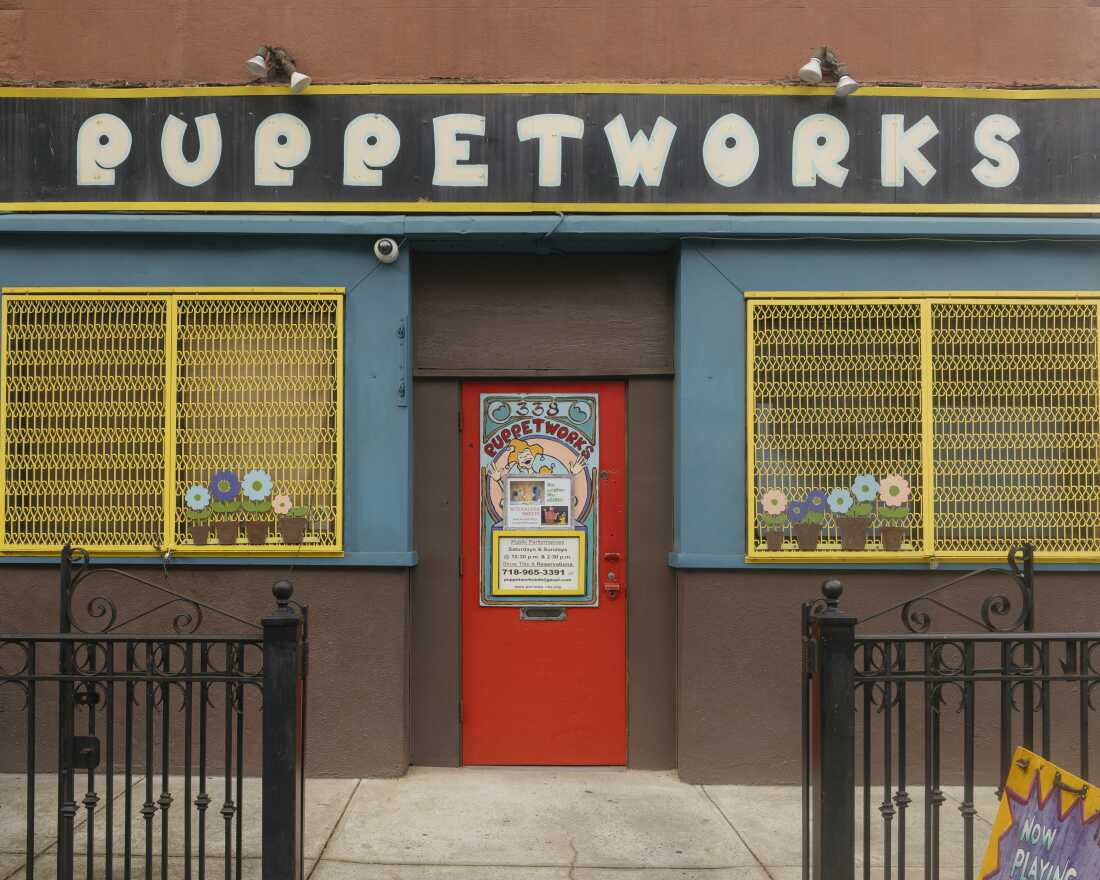
The Puppetworks theater in Brooklyn’s Park Slope neighborhood.
Anh Nguyen for NPR
hide caption
toggle caption
Anh Nguyen for NPR

A workshop station behind the stage at Puppetworks, where puppets are stored and repaired.
Anh Nguyen for NPR
hide caption
toggle caption
Anh Nguyen for NPR

A picture of Nicolas Coppola, Puppetworks’ founder and artistic director, from 1970, in which he’s demonstrating an ice skater marionette puppet.
Anh Nguyen for NPR
hide caption
toggle caption
Anh Nguyen for NPR
For just $11 a seat ($12 for adults), puppets of all types — marionette, swing, hand and rod — take turns transporting patrons back to the ’80s, when most of Puppetworks’ puppets were made and the audio tracks were taped. Century-old stories are brought back to life. Some even with a modern twist.
Since Coppola started the theater, changes have been made to the theater’s repertoire of shows to better meet the cultural moment. The biggest change was the characterization of princesses in the ’60s and ’70s, Coppola says: “Now, we’re a little more enlightened.”

Right: Michael Jones, Puppetworks’ newest puppeteer, poses for a photo with Jack-a-Napes, one of the main characters in The Steadfast Tin Soldier. Left: A demonstration marionette puppet, used for showing children how movement and control works.
Anh Nguyen for NPR
hide caption
toggle caption
Anh Nguyen for NPR

Marionette puppets from previous Puppetworks shows hang on one of the theater’s walls.
Anh Nguyen for NPR
hide caption
toggle caption
Anh Nguyen for NPR

A child attends Puppetworks’ 12:30 p.m. showing on Saturday, Dec. 6, dressed in holiday attire that features the ballerina and tin soldier in The Steadfast Tin Soldier.
Anh Nguyen for NPR
hide caption
toggle caption
Anh Nguyen for NPR
Streaming has also influenced the theater’s selection of shows. Puppetworks recently brought back Rumpelstiltskin after the tale was repopularized following Dreamworks’ release of the Shrek film franchise.
Most of the parents in attendance find out about the theater through word of mouth or school visits, where Puppetworks’ team puts on shows throughout the week. Many say they take an interest in the establishment for its ability to peel their children away from screens.
Whitney Sprayberry was introduced to Puppetworks by her husband, who grew up in the neighborhood. “My husband and I are both artists, so we much prefer live entertainment. We allow screens, but are mindful of what we’re watching and how often.”

Left: Puppetworks’ current manager of stage operations, Jamie Moore, who joined the team in the early 2000s as a puppeteer, holds an otter hand puppet from their holiday show. Right: A Pinocchio mask hangs behind the ticket booth at Puppetworks’ entrance.
Anh Nguyen for NPR
hide caption
toggle caption
Anh Nguyen for NPR
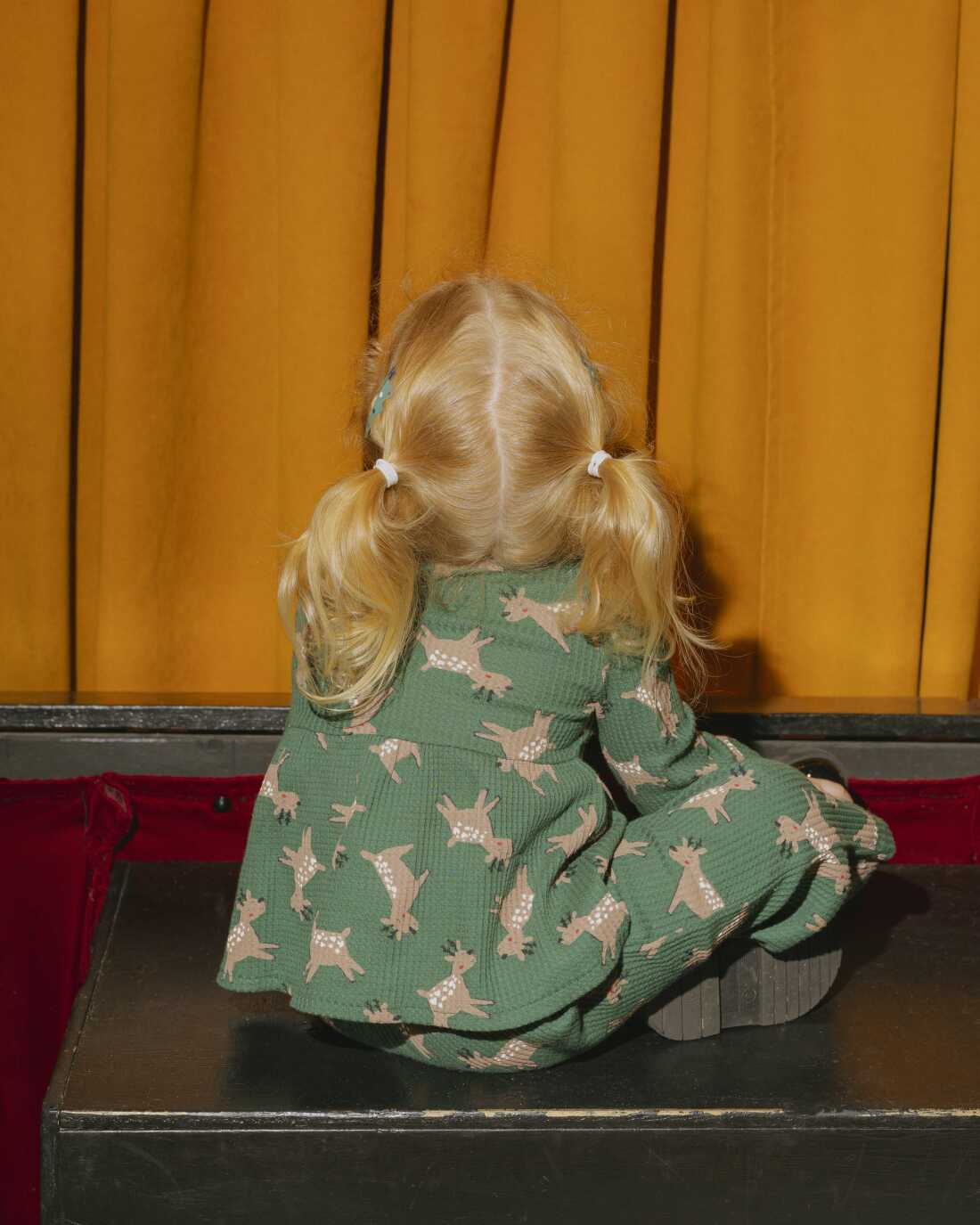
A child attends Puppetworks’ 12:30 p.m. showing on Saturday, Dec. 6, dressed in holiday attire.
Anh Nguyen for NPR
hide caption
toggle caption
Anh Nguyen for NPR

Left: Two gingerbread people, characters in one of Puppetworks’ holiday skits. Right: Ronny Wasserstrom, a swing puppeteer and one of Puppetworks’ first puppeteers, holds a “talking head” puppet he made, wearing matching shirts.
Anh Nguyen for NPR
hide caption
toggle caption
Anh Nguyen for NPR
Other parents in the audience say they found the theater through one of Ronny Wasserstrom’s shows. Wasserstrom, one of Puppetworks’ first puppeteers, regularly performs for free at a nearby park.
Coppola says he isn’t a Luddite — he’s fascinated by animation’s endless possibilities, but cautions of how it could limit a child’s imagination. “The part of theater they’re not getting by being on the phone is the sense of community. In our small way, we’re keeping that going.”
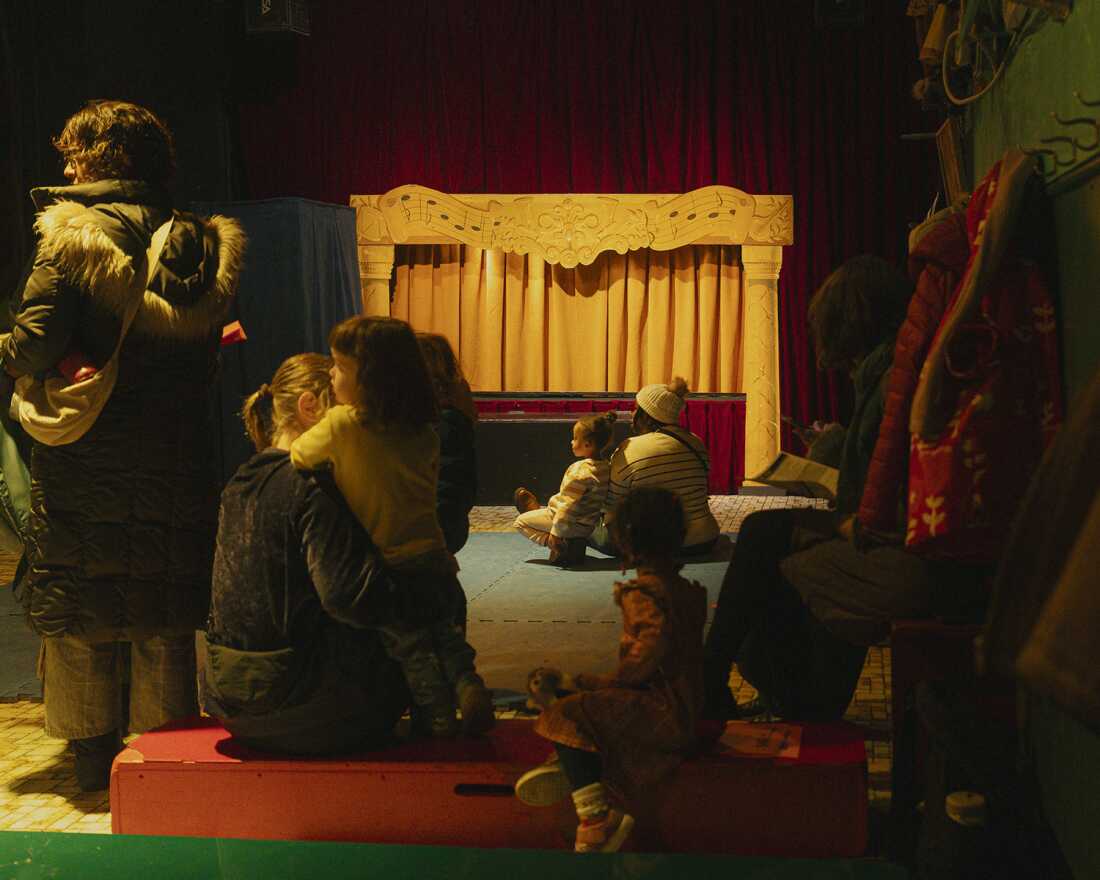
Puppetworks’ 12:30 p.m. showing of The Steadfast Tin Soldier and The Nutcracker Sweets on Saturday, Dec. 6.
Anh Nguyen for NPR
hide caption
toggle caption
Anh Nguyen for NPR
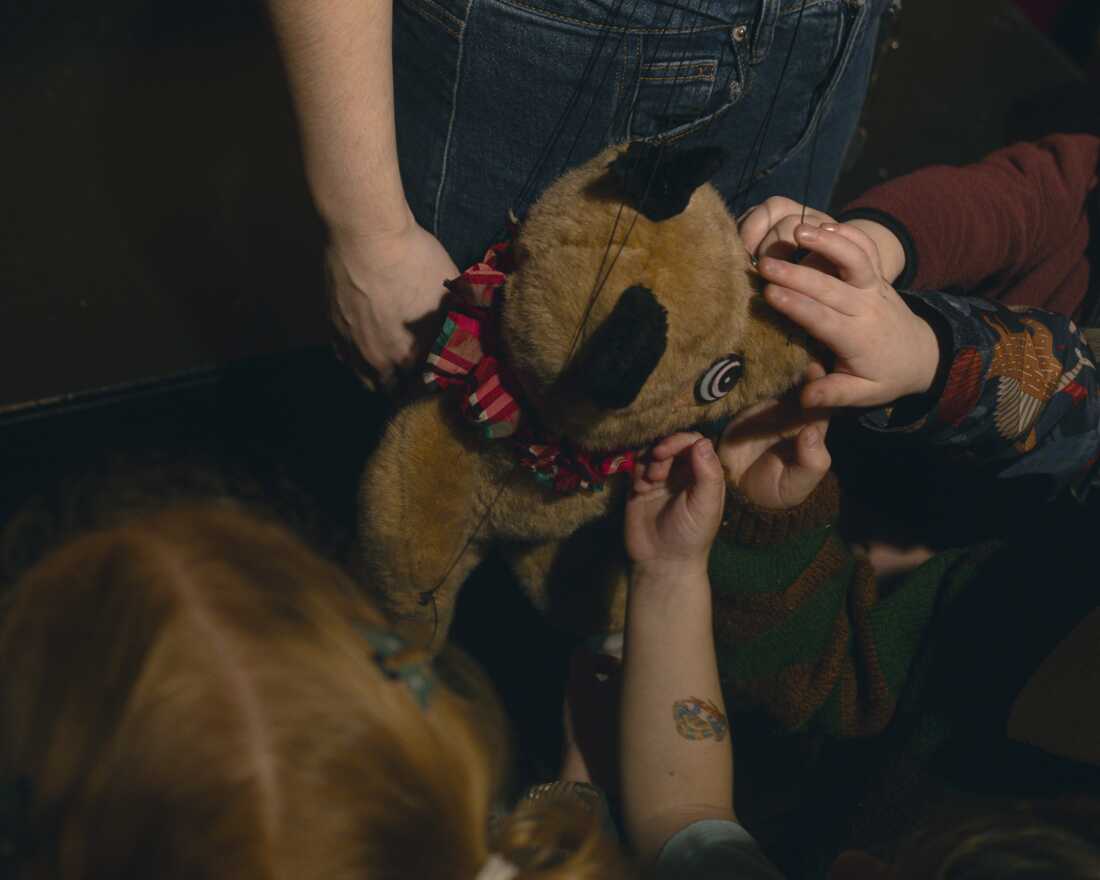
Children get a chance to see one of the puppets in The Steadfast Tin Soldier up close after a show.
Anh Nguyen for NPR
hide caption
toggle caption
Anh Nguyen for NPR
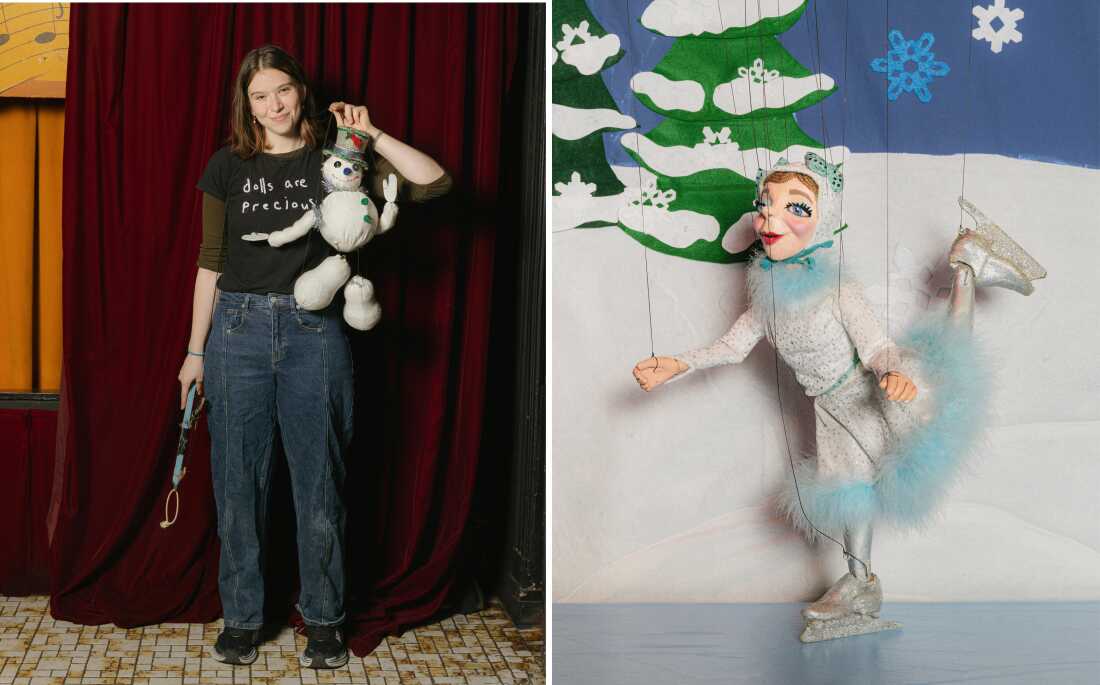
Left: Alyssa Parkhurst, Puppetworks’ youngest puppeteer, holds a snowman marionette puppet, a character in the theater’s holiday show. Right: An ice skater, a dancing character in one of Puppetworks’ holiday skits.
Anh Nguyen for NPR
hide caption
toggle caption
Anh Nguyen for NPR
Community is what keeps Sabrina Chap, the mother of 4-year-old Vida, a regular at Puppetworks. Every couple of weeks, when Puppetworks puts on a new show, she rallies a large group to attend. “It’s a way I connect all the parents in the neighborhood whose kids go to different schools,” she said. “A lot of these kids live within a block of each other.”

Three candy canes — dancing characters in one of Puppetworks’ holiday skits — wait to be repaired after a show.
Anh Nguyen for NPR
hide caption
toggle caption
Anh Nguyen for NPR
Anh Nguyen is a photographer based in Brooklyn, N.Y. You can see more of her work online, at nguyenminhanh.com , or on Instagram, at @minhanhnguyenn. Tiffany Ng is a tech and culture writer. Find more of her work on her website, breakfastatmyhouse.com.
-

 Iowa1 week ago
Iowa1 week agoAddy Brown motivated to step up in Audi Crooks’ absence vs. UNI
-

 Maine1 week ago
Maine1 week agoElementary-aged student killed in school bus crash in southern Maine
-

 Maryland1 week ago
Maryland1 week agoFrigid temperatures to start the week in Maryland
-

 New Mexico1 week ago
New Mexico1 week agoFamily clarifies why they believe missing New Mexico man is dead
-

 Detroit, MI1 week ago
Detroit, MI1 week ago‘Love being a pedo’: Metro Detroit doctor, attorney, therapist accused in web of child porn chats
-

 Health1 week ago
Health1 week ago‘Aggressive’ new flu variant sweeps globe as doctors warn of severe symptoms
-

 Massachusetts1 week ago
Massachusetts1 week agoMIT professor Nuno F.G. Loureiro, a 47-year-old physicist and fusion scientist, shot and killed in his home in Brookline, Mass. | Fortune
-

 Maine1 week ago
Maine1 week agoFamily in Maine host food pantry for deer | Hand Off





















